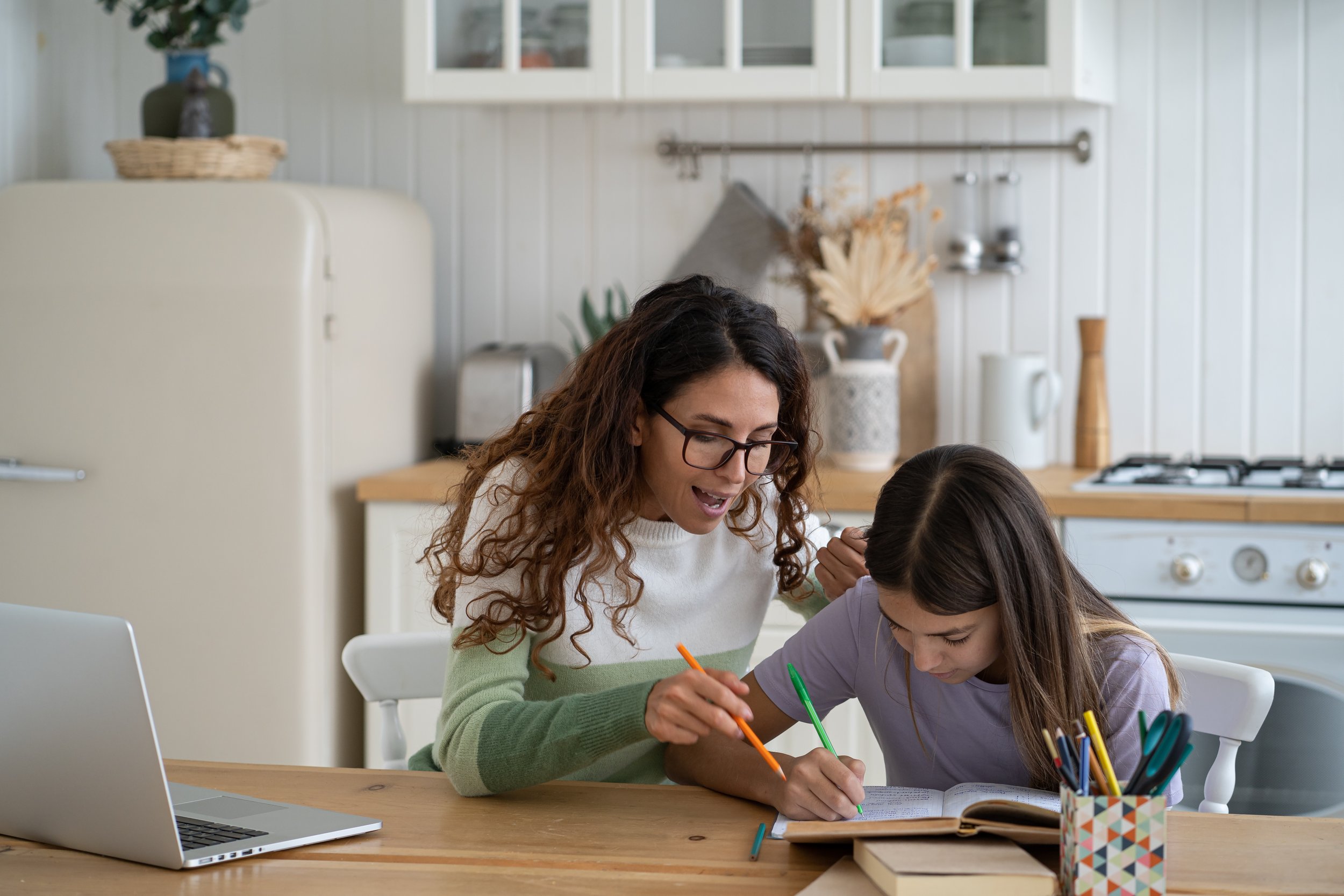We All Know Self Care Is Important—But Where Do You Find the Time?
Self-care is an essential part of the homeschool equation for secular homeschool moms, and you’re going to have to be deliberate about fitting it into your days.
Self-care is an essential part of the secular homeschool equation, but you’re going to have to be deliberate about fitting it into your days.
A decade ago, I began homeschooling my children for selfish reasons. Sure, I thought homeschooling would be good for them too, and I read a stack of books about childhood development, learning styles, and homeschooling methods to back up that belief, but ultimately my reasons to homeschool were selfish. I wanted my children to learn free of negative social influences, gold star grading systems, and hours of pointless homework, but mostly I didn’t want to wake up early every day to rouse my sleeping children, pack brown bag lunches, and hurry them out the door. Waking up naturally and snuggling on the couch to read books before we began our day of curiosity driven learning was my romanticized fantasy of homeschool life.
There were many days that we lived out my fantasy, but many more days that I lost myself in the service of parenting and homeschooling. When mothers with more experience than I had counseled me to take some “me time,” I didn’t even know what they meant. All the hours not devoted to the enrichment of my children were spent cleaning up from said enrichment, planning for the next day’s enrichment, and recovering from all the enrichment, plus the usual business of running a household. When exactly was this “me time” supposed to happen, and what was I supposed to be doing for myself?
I recently listened to an interview with a 107-year-woman, and when asked for the secret of her longevity her answer was to eat well, exercise, sleep, and avoid stress — four of my favorite things to do now, but not my priorities during those early years of homeschooling. Hearing it from a woman with a tremendous amount of life experience affirmed that taking care of myself is my definition of “me time,” and hopefully it will buy me even more time.
As the new school year approaches, and you thoughtfully select and prepare curriculum for your children, consider the enrichment of yourself as well. Schedule “me time” in your daily planner, and keep the lesson plan simple: eat well, exercise, sleep, and avoid stress.
Here are a few sample assignments:
Eat vegetables with your breakfast, because at the end of a long day when the idea of making a salad seems as monumental a task as teaching Latin to a preschooler, and you wonder if the marinara sauce on your pasta counts as a vegetable, at least it won’t be your only vegetable that day.
Station your kids on the front porch with a timer and have them record how long it takes you to walk (or run!) around the block multiple times. Find the mean, median, and mode of your times and call it a math lesson. Extra credit if they cheer you on.
Schedule a 20-minute power nap for that particularly stressful time of day when you begin to consider packing a lunch for your children and dropping them off at the nearest public school.
Replace a “should” with a “want”: I should (insert an activity that stresses you out), but I want to (insert an activity that feeds your sense of self). You can’t avoid all shoulds in life, but if you’re not careful you may successfully avoid all of your wants.
One of the greatest lessons I learned and passed on to my children is the importance of taking care of oneself. If you don’t make yourself a priority, who will? A bonus to this lesson is that others often benefit from your acts of selfishness. My selfish desire to homeschool was a selfless act of service to my children, and an inspiration for friends to choose alternative educational paths.
Families make great sacrifices of time, energy and resources in order to homeschool, but caring for yourself does not have to be part of that sacrifice. This school year, make “me time” a mandatory subject. What is good for you is also good for your children.
Growing Curiosity
The way I garden is the way I homeschooled. I planted seeds, added plenty of supplies, space and time, and hoped for the best.
The way I garden is the way I homeschooled. I planted seeds, added plenty of supplies, space and time, and hoped for the best.
“How you do one thing is how you do everything,” I read on the back of a shirt. The quote has been running through my mind all summer as I’ve been inventorying my life thus far, a process inspired by turning forty and having a child graduate from high school. Milestones have a way of tripping me up and making me look backwards to see what I tripped over.
The quote rings most true when I sit on my back porch and contemplate my garden. How I garden is how I do everything. I plant seeds, add water, and hope for the best. Last May we relocated our garden to a different part of our yard, built a fence around it to keep the dog out, and constructed several low and long garden boxes. My husband installed an automatic sprinkler system, and I planted a variety of seeds and seedlings.
For the first few weeks of summer, I’d go out every morning and check how many seeds had sprouted and how much taller the tomatoes had grown inside their cages. Then I started to notice seeds I hadn’t planted sprouting in between the garden boxes. Some I recognized as edible — purslane, tomatillos, borage, squash — so I left them to grow rather than weeding my rows.
By mid summer, my garden was a jungle. The raised beds were no longer visible. The tomatillos grew taller than me and competed with the cucumbers for vertical growing space on the trellis. The purslane made it impossible to walk between garden boxes, and the borage grew so bushy that I had to hang on to the fence to edge around it, careful not to disturb the dozens of bees buzzing among the purple blossoms. The single zucchini seedling I planted crowded out the bush beans, which in turn grew at an angle, seeking sunlight, and crowded out the beets. The beets didn’t stand a chance when the lettuce in front of them bolted during a particularly hot week in July.
All of this is to say the way I garden is the way I homeschooled. I planted seeds, added plenty of supplies, space and time, and hoped for the best. Some of the curriculum I carefully selected was crowded out by interests discovered by my children, such as the state by state unit study I purchased online which they rejected in favor of collecting commemorative state quarters to fill up a coin collector’s map of the United States.
Some topics popped up out of nowhere and grew with us for years, like the Percy Jackson book we listened to on a road trip which inspired a deeper study of Greek mythology, culture and language. Our interest in geology began similarly, with a single unusual rock found on a walk along the railroad tracks, a discovery which prompted us to collect and study a stack of books about rocks and minerals, go on field trips to mines and rock shops, and spend countless hours rock hunting to amass a large collection of unusual rocks.
Other topics grew steadily, occupying exactly the space we had allotted, never overshadowing other topics, but occasionally surprising us with growth spurts, like the math curriculum we tended to every day, which grew into a solid foundation for my children to advance their math skills when they transitioned into traditional school. My daughter texted me while on break during her first college math class to say, “I finally understand scientific notation!” A seed planted years ago had finally sprouted.
It’s now late summer. As I survey my garden I see ten foot tall sunflowers so heavy with seeds that they’re bent over, their tired blossoms touching the ground. The yellowing cucumber vines have conceded to the tomatillos, which are bursting from their chartreuse green, paper like wrappers. The tomatoes are so overgrown I can no longer see the metal cages which once dwarfed them. It’s time to harvest the fruit, save a few seeds for next summer, and start planning and planting our winter garden.
It’s also time to sort through the cabinet full of homeschool curriculum my children have outgrown; recycle the math notebooks, keep a few samples of writing for posterity, and pass along the state by state curriculum, never used, to another homeschooling family. Perhaps I’ll pop the coins out of our state quarter map and pass the map on as well, see which one sprouts interest in their children. It will be like sharing seeds with fellow gardeners, who, like me, grow curiosity.
Mindful Homeschool: Embracing Your Roots
My husband asked me to go to the bike shop with him the other day to try out some mountain bikes. This was one week after he asked me to go on a trail ride with him and deemed my twenty year old mountain bike unfit and unsafe.
“You need a new bike so we can ride more trails,” he said.
“But I’d rather buy an unlimited membership at the yoga studio,” I said. For the price of the bikes he is looking at, I could buy several years worth of unlimited yoga classes and a car for our daughter. Today’s bikes cost as much as my first two cars combined. Two wheels for the price of eight.
I must admit that the new bike felt great, and I was tempted to let him plop down our credit card so I could ride the bike home. Ultimately we decided to think about it and shop around a bit more.
Biking is my husband’s thing, yoga is my thing, and when I think about it, each of our preferred activities is suited to our different lifestyles. As the sole financial provider for our family, my husband is get up and go go go. Flying down mountains and climbing back up them is the training he needs for, and the relief he needs from, his physically demanding job.
As the sole care provider for our family, I am get up and stay stay stay. Struggling to stay on my yoga mat, balancing on my hands and feet, and listening is the training I need to be present for my demanding job as mom/counselor/nutritionist/home-economist/emergency-responder. An hour of not talking and just moving in a hot studio keeps me from being a hot mess at home.
You know as well as I do how much work it is to stay in one place and focus on the task at hand. There are days when the idea of getting up and leaving the house to go to work seems like the ideal vacation. More than once I have wished for a performance review and a bonus check as an indicator that I am doing a good job. As homeschooling parents, we don’t even get the little validation from a satisfactory report card and a written comment from the teacher about what a good little student we have. Teaching our own is a way of living, but certainly not a way to make a living, and while our labor is unpaid, it is certainly not without benefits.
Trail riding is fun, and there will be a day when I will say yes to a bike. If do my job well and my kids learn to take care of their future selves, my current job will become obsolete and I will have the time to hit the trails on two wheels. For now I’m going to stick to two hands and two feet, or no hands and one foot, on my yoga mat. It takes a lot of work to stay in one place, but the place I’ve chosen to be is the best place for me, for my family, for now.
Living the Homeschool Dream... in Real Life
A friend recently joked, “I’m living the dream! It’s not my dream, but it’s somebody’s dream!”
Years ago, when my children were still in elementary school, I dreamed about moving my family to Central America for a year. Complete and total immersion. We’d all become fluent in Spanish. We’d see flora and fauna we’d never before seen. We’d eventually make friends with the suspicious locals. I would wear embroidered tunics and learn to cook in a whole new way. Never mind that our family has never traveled outside of the United States, or even east of the Rocky Mountains, we could become, at least temporarily, expatriates!
“But what about my job?” asked my husband.
“But what about our friends?” asked my children.
“But what about my dream?” I responded.
“I truly felt happy for the family who experienced what sounded a lot like my dream. If I didn’t have the experience, at least somebody else did.”
My dream never made it further than a stack of books from the library and a mini lesson on the geography and culture of Central America. I only have one embroidered tunic, which I found at a thrift store and never wear. It’s not really my style. Travel isn’t really my style either. I’m a homebody. Vacations longer than three or four days make me a bit panicky. My solution to seeing more of the world without vacationing was to make a home somewhere else.
When I ran into an old acquaintance at yoga, my dream to live abroad came rushing back as she told me about her family’s adventure. They had lived in South America for six months, during which time they homeschooled their three children, and exchanged work for a place to live. Her eyes lit up as she told me about the incredible places they visited, the experiences they had, and the people they met. “You lived my dream!” I told her.
I have a saying that helps me to live a more minimal lifestyle: Be happy that it exists without needing to possess it. “It” being whatever that thing is I find myself wanting - usually a material item - but squatting on the floor of the yoga studio, hearing about living and learning in South America, I realized “it” can also be an experience. In my sweat drenched, post yoga euphoria, I truly felt happy for the family who experienced what sounded a lot like my dream. If I didn’t have the experience, at least somebody else did.
As homeschoolers, it doesn’t always feel like we’re living the dream - our children may balk at our carefully crafted lesson plans; the dining room table is always a cluttered mess; we wake up in the middle of the night worrying that we’re doing it all wrong. Chances are, however, that we’re living someone else’s dream. There is a mom at work right now who wishes she was home with her children. There’s a dad teaching a room full of students who dreams of staying home to teach his own kids. There might even be a family in Central America wishing they could live and learn in California for a year. If you know them, I’d love their contact information. Maybe they’re interested in a house swap. Some dreams don’t disappear, they just take longer to become reality.





































MOLLY DUNHAM lives on the edge of a wild river canyon in the foothills of Northern California with her family. She enjoys hiking with friends, lifting heavy weights, and paddle boarding in the dark. But mostly she's a home-loving word nerd, happiest among works of creative non-fiction, spiral bound notebooks, and sharpened yellow pencils.